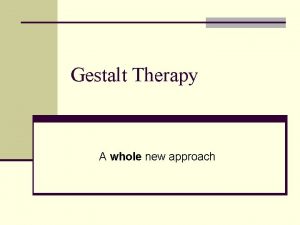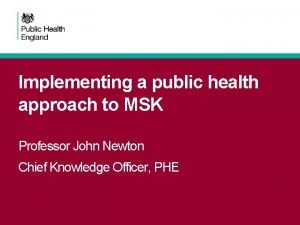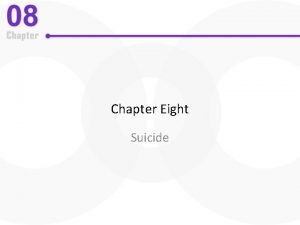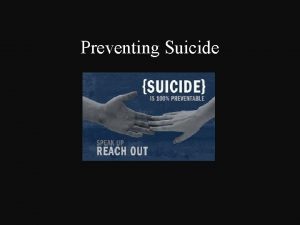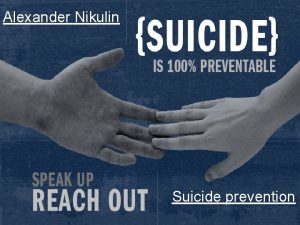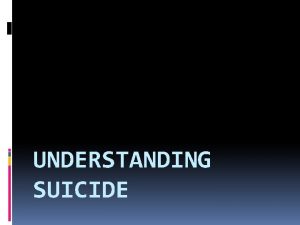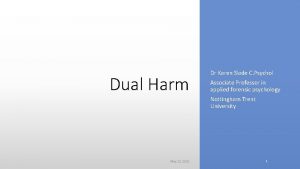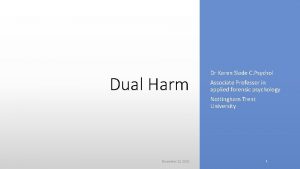Suicide a whole prison approach Dr Karen Slade











![“Previously it had felt inevitable …. but [we] gave this prison hope that we “Previously it had felt inevitable …. but [we] gave this prison hope that we](https://slidetodoc.com/presentation_image_h2/52a82bdbb196bbe44affc8df666570fd/image-12.jpg)













- Slides: 25

Suicide: a whole prison approach Dr Karen Slade email: Karen. slade@ntu. ac. uk Senior Lecturer & Forensic Psychologist Nottingham Trent University

Overview • Organisational suicide prevention ü Key elements of an effective organisational approach • Co-ordination and Integration ü Integration of Services ü Integration of Theory and Practice ü Integration of Risk • Communication ü Information sharing • Postvention ü What happens post-suicide ü Impact and caring for staff and prisoners

Organisational Suicide Prevention Key elements of an effective whole prison approach “ Suicide is everyone’s concern” (HMIP, 1999) NOMS guidance: PSO 64/2011 June 2021 3

History still relevant today. Liebling (UK) and Howells (Australia) in the 1990 s argued for the importance of an organisational and integrated approach. Rather than an exclusive focus on the ‘vulnerable’ prisoner and silo working - it is important to focus on the regime, culture and atmosphere of the whole prison – promoting a healthy and protective environment. But also and most critically… It can significantly reduce suicide even when no specialist suicide prevention interventions are available June 2021 4

Self-inflicted deaths in prison custody 20072009 (PPO, 2011) Issues include: • Do Not Attend (DNA) appointments • Prevalence of mental health concerns: over half of SID prisoners were prescribed psychotropic drugs in the three months prior to death, including anti-depressant, anti-psychotic and mood stabilising medication (55% of cases). • Non-compliance with medication: nearly a third of these prisoners were not fully compliant with their prescription plan (31% of cases). • Lack of clarity, stopping (or not starting) prescriptions (e. g. delays in community GP confirmations; or limited integration within prison health services) • Cynicism as to motives (later confidentiality, information sharing, communication) June 2021 5

Whole Prison Integration: Issues and Options? June 2021 6

Prison suicide reduction • A Remand prison devised and implemented a new and radical strategy to suicide prevention and experienced an exceptional sustained reduction in suicide calculated at a 2 in 100, 000 chance to occur by chance. • The study retrospectively considered staff perceptions (and external opinions) on the vital ingredients for this outcome… • The usual aspects were present…screening, good training, frequent and good quality assessment but with the strongest elements being around prison culture and integrated working. SLADE, K. and FORRESTER, A. (2015) Shifting the paradigm of prison suicide prevention through enhanced multi-agency integration and cultural change. The Journal of Forensic Psychiatry & Psychology, 26 (6), pp. 737 -758.

Integration of Services Arguably much more difficult as beyond ‘information sharing’ but collaborating in strategic decisions and joint care. • Coherence for patients and staff • Reduces ‘blame culture’ with joint care comes joint responsibility • Increases understanding of other professional needs and decisionmaking processes • Developmental opportunity • Can be empowering for staff (to not be undermined or contradicted without discussion!) June 2021 8

Considerations • Do you know how you fit with the wider prison strategy? • Which integrated strategy OR practice OR individual care approaches (meetings/data systems) are there across and within health and prison staff? • What ‘level’ of management/front-line staff are those meetings held? • How effective are they at considering the broad picture of the prisoner experience and breaking down the professional responsibilities? • Do they consider the effect (practical /emotional) on the range of staff necessary? June 2021 9

Senior Management support for cultural change

Specific examples Underlying culture of integration Shift from a security to a case management focus including. . • Highly limited use of segregation • Integration of suicide prevention as a central concern in all strategic decisions. Management and leadership approach • Positive and optimistic attitude with clear prioritisation: ‘Suicide is not inevitable’ • Supporting innovative approaches and individualised risk management • Swift, critical and wide-reaching learning from incidents • Clear expectations • Staff held accountable BUT only with constructive guidance, feedback and emotional support (not just issuing guidelines but personal and flexible).
![Previously it had felt inevitable but we gave this prison hope that we “Previously it had felt inevitable …. but [we] gave this prison hope that we](https://slidetodoc.com/presentation_image_h2/52a82bdbb196bbe44affc8df666570fd/image-12.jpg)
“Previously it had felt inevitable …. but [we] gave this prison hope that we could stop it”

Cross-professional collaborative working

Specific examples Communication and pro-active partnership working • Complex cases meeting and framework for wider integration • Joint and open case management system across services Specialist knowledge and experience for strategic management • Understanding of the nuances of the research; risk management; the environment, client group and the key services allowed for practical and effective strategy. Debriefing and learning from experience • Ongoing and regular staff support and guidance system for staff in dealing with prisoners at risk. Support included professional, emotional and practical support.

Integration of Theory and Practice Suicidal behaviour • Behaviours are underpinned by a mix of psychology, biology, social influences, individual factors and context. • To predict and to manage the behaviour it is important to understand the detailed ‘Why’ someone is at risk. • The bad news…there are NO measures to predict suicidal behaviour • The (somewhat) good news…there are tools under development to help referral decisions to services. • Know the risk groups and factors but lists of ‘risk factors’ need to be understood for the individual within the story of a complex behaviour. • Know who is on ACCT and why (who is tasked with recording that? ) June 2021 15

Issues from Pre-custody • Suicide risk is under-considered in the current CJLD pathway services • Suicide risk without mental health concerns (current symptoms or previous psychiatric care) does not trigger services or assessment (Slade, et al. 2016) Issues • Of those who become acute in first days of prison – high proportion (up to 50%) displayed clear suicide risk and behaviour without MH concerns in police custody • Reception health services had not seen police risk assessment and not in health records. • Prison services cannot rely on pre-custody services Slade, Samele, Valmaggia and Forrester (2016) Pathways through the criminal justice system for prisoners with acute and serious mental illness, Journal of Forensic and Legal Medicine 44, 162 -168. June 2021 16

Integration of Risk Dual Harm: Harm to Self and Harm to Others Community: Exposure to violence increases risk of SH and suicide ideation (Vermeiren, et al. 2002) BUT conducting repeated violence is a stronger risk of suicidal behaviour (Jordan & Samuelson, 2015) Prison: Between 28 -60% of those engaging in violence in prison will also harm themselves in prison (Slade, in press) and vice versa Added to prison guidance that ‘Recent violence’ should be a risk factor Jordan, J. and Samuelson, K (2016 Predicting Suicide Intent: The Roles of Experiencing or Committing Violent Acts, Suicide Life Threat Behav, Jun; 46(3): 293 -300 Slade, K. (in press) Dual Harm: Distinguishing the characteristics for dual violence and self-harm in prison, Criminal Justice and Behavior June 2021 17

Service issue: Conflict in underlying assumptions and Response Zero Tolerance Punishment Individualised Supportive Care Segregation or Care Suite?

Communication From Prison and Probation Ombudsmen Learning Lessons: Prisoner Mental Health Lesson 17 All healthcare professionals have a responsibility to share with prison staff any information that might affect a prisoner’s safety, within the boundaries of medical confidentiality. Lesson 18 All healthcare teams involved in the care of a prisoner should communicate with each other and share information, to ensure consistency in diagnosis and a collaborative approach to treatment June 2021 19

Information sharing • Repeatedly, a critical issue for inquest or independent investigations • Ignorance is a limited defence if that information was available Some of the problems • Assuming ‘someone will tell me if its important’ or ‘they already know’ • Information sharing is overly restrictive • Structures or policies in place not operating well e. g. Delays in receiving suitable community GP records or poor record keeping (PPO, 2013) • Not understanding the information needed by other professions/held by them e. g. prison records which have health data (Slade et al. , 2016) June 2021 20

Information sharing Considerations: • Who is responsible for checking the prison information – and passing on the health information? • Do you wait for information to arrive or are there proactive processes in place? • What are the ‘terms’ which you apply or triggers for passing on information? Are they at the right level (or is it critical/imminent risk/expressions of suicide only)? • How is that information shared and to whom (and when)? June 2021 21

Postvention The impact of a suicide or SID on professional health staff has been researched across many professions – although rarely in prisons. Some of the known impacts include (e. g. Draper et al, 2014; Faberow, 1993): Professional Life: Increased referrals to psychiatry, improving accuracy of medical records, prescribing more antidepressants. Personal Life: feelings of guilt or inadequacy, self-doubt in competence, fears about professional reputation, disrupted sleep Suicide occurring within one week of last consult and <5 years experience enhances effects (Draper et al, 2014). Draper, B (2014) The impact of patient suicide and sudden death on health care professionals, General Hospital Psychiatry, 36 (6), 721 -725 June 2021 22

Postvention support Usual first line: Informal support from colleagues. Most GPs report that they did not receive enough support: up to 20% gained support; with 62% saying they wanted it (Halligan & Corcoran, 2001). Professional Support: • reflective supervision with (prison) experienced colleague • meeting with safer custody lead and relevant clinical lead to understand the fuller story and/or attend prison hot and cold debriefs. • Meeting with legal representatives to get advice Personal Support: • A good friend or family member • prison care team • employee counselling services (rarely used) June 2021 23

Postvention support Which options are available within your service/prison? How could they be better utilised? What should be developed? What could be developed? June 2021 24

Dr Karen Slade Karen. slade@ntu. ac. uk 0115 848 5589 25
 Karen slade
Karen slade Cdc whole school whole community whole child
Cdc whole school whole community whole child Slade lindsay
Slade lindsay Brain way e gore drama
Brain way e gore drama Amfifilnost
Amfifilnost Jennifer slade
Jennifer slade Ken slade
Ken slade Audrey slade
Audrey slade Adrian slade
Adrian slade Kelvin slade
Kelvin slade Whole part whole practice
Whole part whole practice Gestalt therapy goal
Gestalt therapy goal Whole school approach to cultural diversity
Whole school approach to cultural diversity Whole system approach to obesity
Whole system approach to obesity Whole farm approach
Whole farm approach Whole system approach to obesity
Whole system approach to obesity Dyslexia
Dyslexia Whole system approach to obesity
Whole system approach to obesity Whole community approach
Whole community approach Ralph waldo emerson famous quotes
Ralph waldo emerson famous quotes Why people die by suicide joiner
Why people die by suicide joiner Mental health faucets
Mental health faucets Hitler suicide
Hitler suicide Youth suicide research consortium
Youth suicide research consortium Mrs dalloway summary
Mrs dalloway summary Detergent suicide how to make
Detergent suicide how to make











